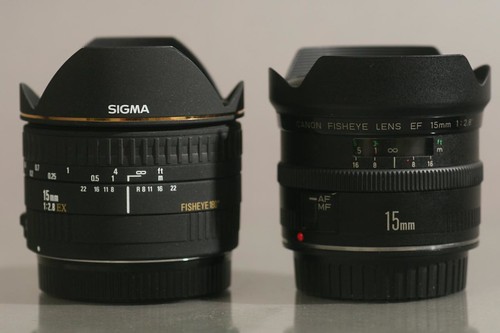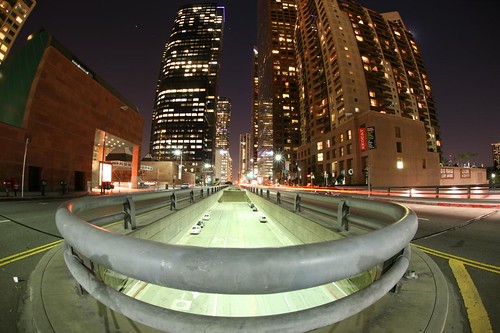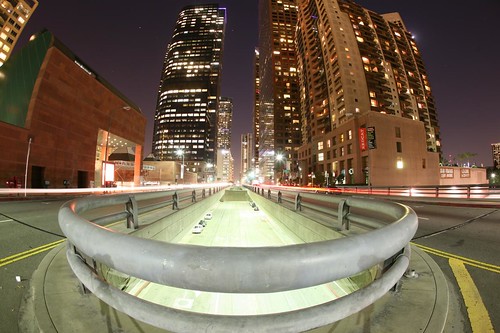
In true curber fashion, I found a good deal on a Sigma EX 15mm f/2.8 Fisheye lens and bought it! I have no intentions of keeping both. Initially, I had intended to keep the Sigma and sell the Canon as it would put more money in my pocket and since this would be a luxury since it is a lens that I rarely have the need for. In fact, after a year of owning the Canon, it only comes out of the bag during drunk moments ... "Lets take fffffffisheye p-p-p-photos!!!" And for that, I wouldn't really need sharpness, high lens IQ, etc.
First impressions ... The Sigma feels bulkier but not as well-built compared to the Canon. The two-part front lens cap of the Sigma might get annoying in the long run and that makes it two pieces that I may eventually lose. Oh, the Sigma rear lens cap ... Sigma lens owners know what I'm talking about. It is the scourge of the earth - frustrating at times, as it only goes in one way - you have to match the dots, unlike the Canon rear lens cap where you slap then twist, done! Moving on, the Sigma EX came with a pretty nice lens case. I can't say that with the Canon. In fact, I can't even say "it came with a case" with regards to the Canon. $650 for a lens, you can't give me a pouch, case, or something? I think this is essential for a novelty type lens considering that its not going to stay on the camera for long periods of time (unless that is your thing, to each his own). So dust accumulation might be a problem in the long run since the lens cap slides on instead of locking on - it may suck up dust while sliding it off or on. The zoom ring of the Sigma EX is also better, focuses faster and quieter. I didn't delve into the efficiency of the autofocus though. One weird thing about the Canon, when autofocusing, the lens barrel does not extend but the front element does! Its trippy to watch that big piece of glass moving forwards and backwards within the built-in lens hood. Another reason for the need of a pouch.
On to images ... I'm not a pixel peeper type of guy. I'm pretty much just into the aesthetic of the image. I don't really care if its sharper around the edges etc. etc. And with review of these lenses, barrel distortion shouldn't be a factor (or is it?). Anyways, on to the images ...
Sigma Shot # 1 (f/8 at 30 sec, ISO 100, Tungsten White Balance)

Canon Shot # 1 (f/8 at 30 sec, ISO 100, Tungsten White Balance)

Sigma Shot # 2 (f/7.1 at 30 sec, ISO 100, Tungsten White Balance)

Canon Shot # 2 (f/7.1 at 30 sec, ISO 100, Tungsten White Balance)

I took about 6 shots using the same process. Shoot with the Sigma, remove and mount Canon, Shoot. Repeat. The results were pretty consistent - not much between them BUT the sticking point is that it seems like the Canon produces brighter photos. By bright, I meant if it was "properly exposed" on the Sigma, it is very slightly overexposed on the Canon. This is illustrated in Shot # 2 above. HamburgCam from Flickr! commented on Canon Shot #2 above that:
Thank you for your comparison photos. From what I can see in the 1280Pixel Resolution samples, the Canon lets more Light in at f/7.1, it seems to be a tiny bit wider on the sides (hairsplitting, I know) but sharpness is difficult to judge from these samples. Especially since the Canon photos are brighter and lost more detail in the well lit areas.
My conclusion? I can't really come up with one because I think the color and sharpness comparisons would not really be the same since the Canon seems let in more light. Based on my Flickr! account - oddly enough, two people commented on the Canon photos, but not on the Sigma photos. Also, the Canon photos have been viewed more than the Sigma photos. Coincidence? Hmmm ... I think I'm keeping the Canon.
UPDATE: I listed the Sigma on eBay earlier ... it sold after an hour!





Personally I like the darker images of the sigma better, but thats just me.
ReplyDeletei think its that way because the canon lets in a little bit more light. and it gets amplified over the 30 second exposure
ReplyDelete